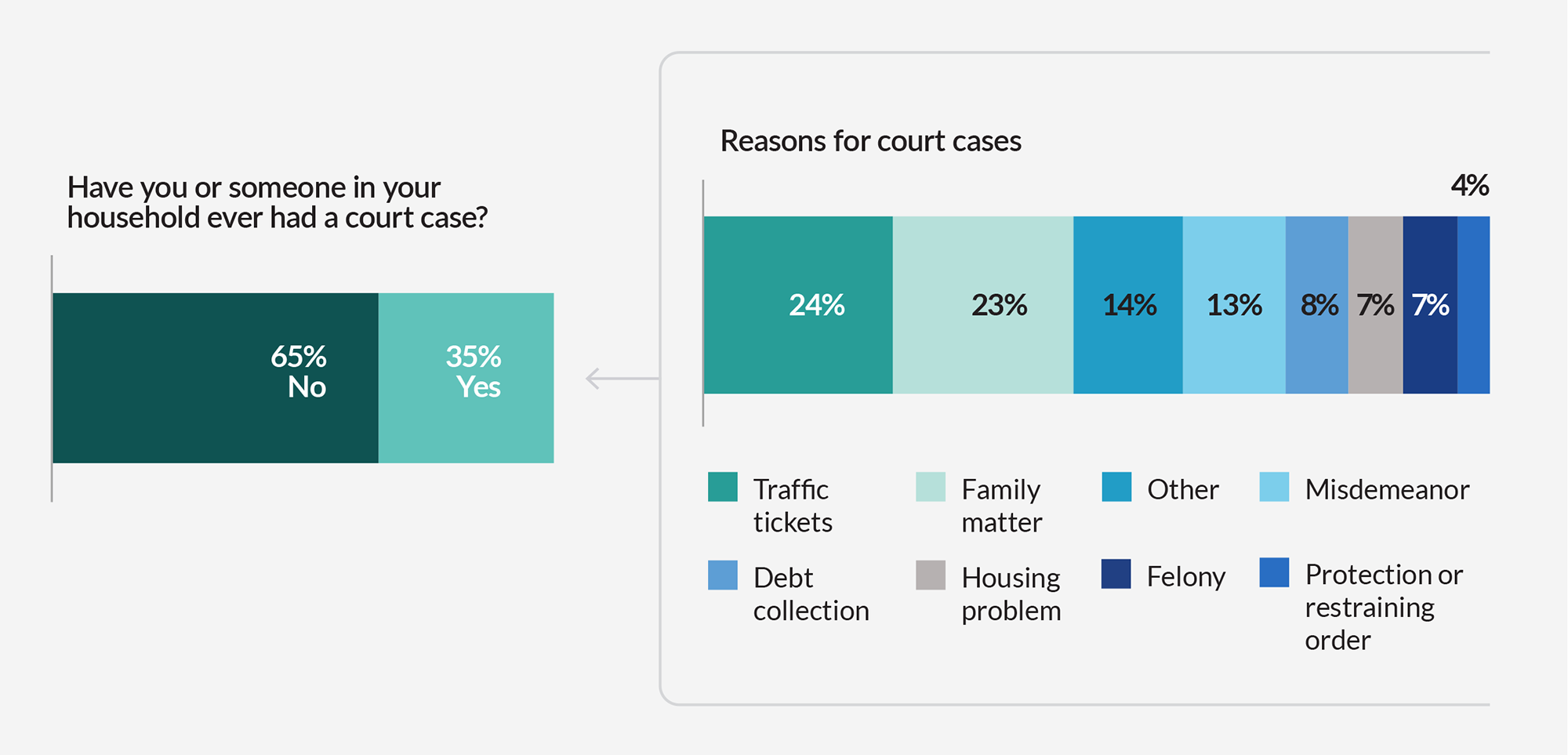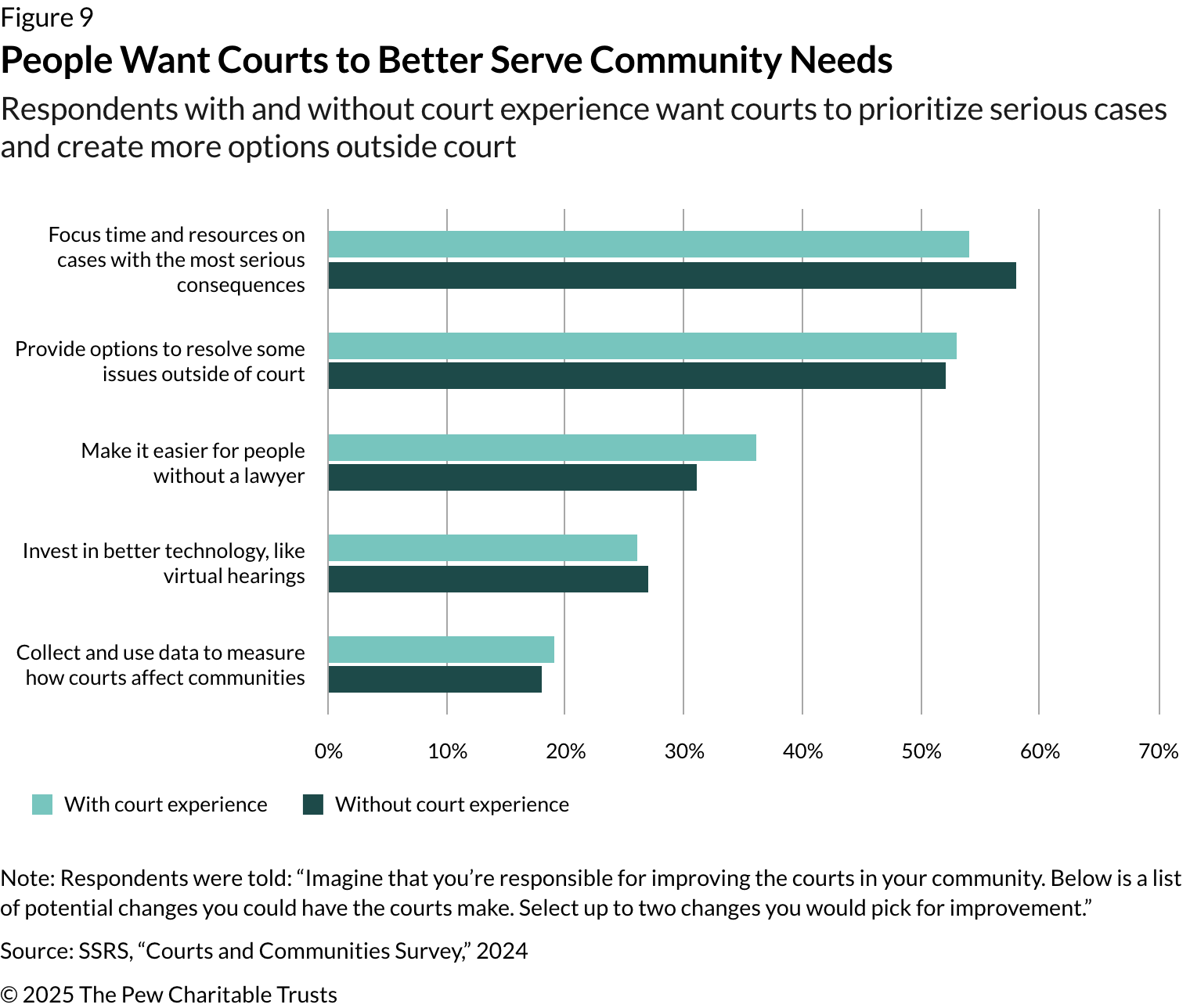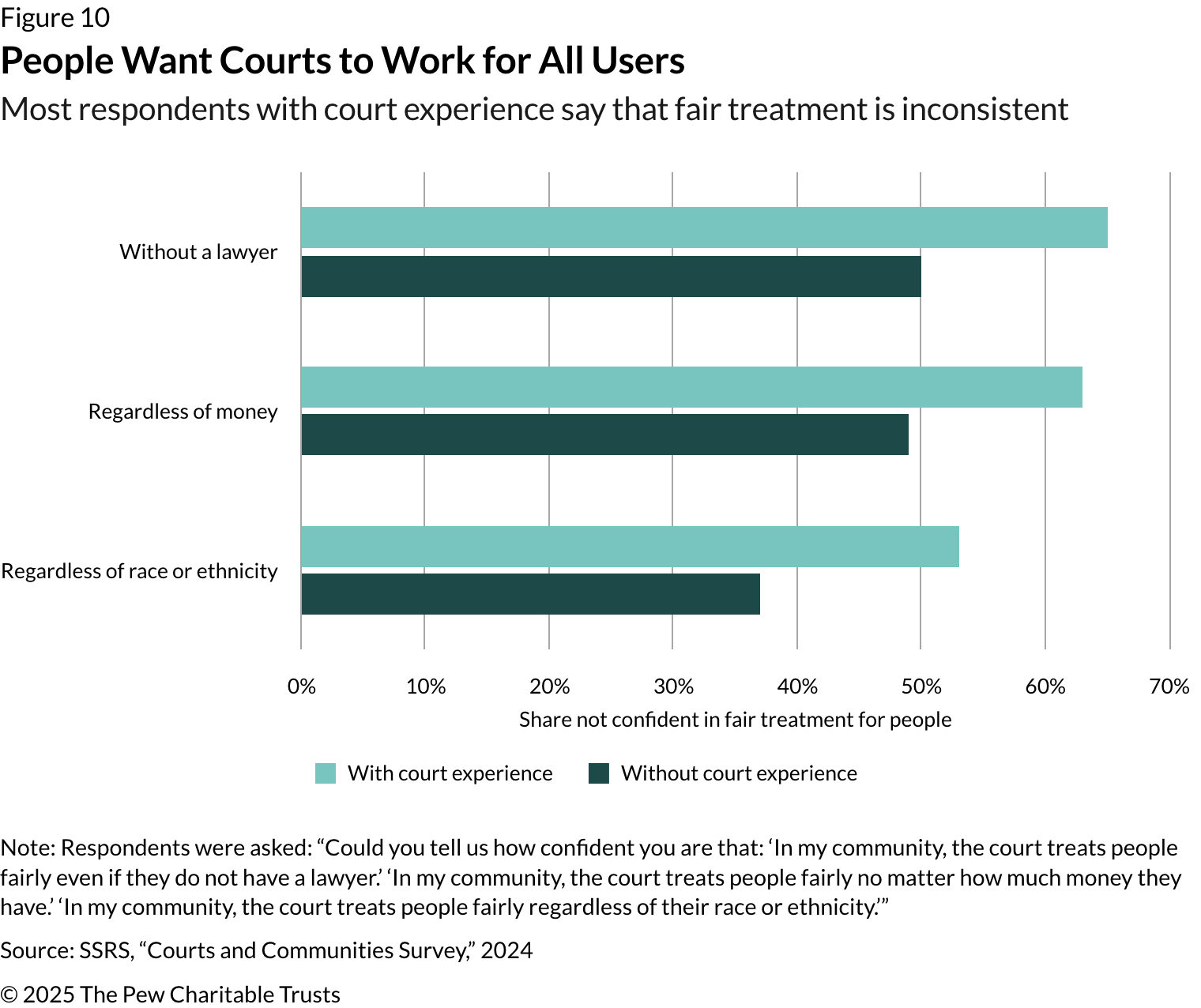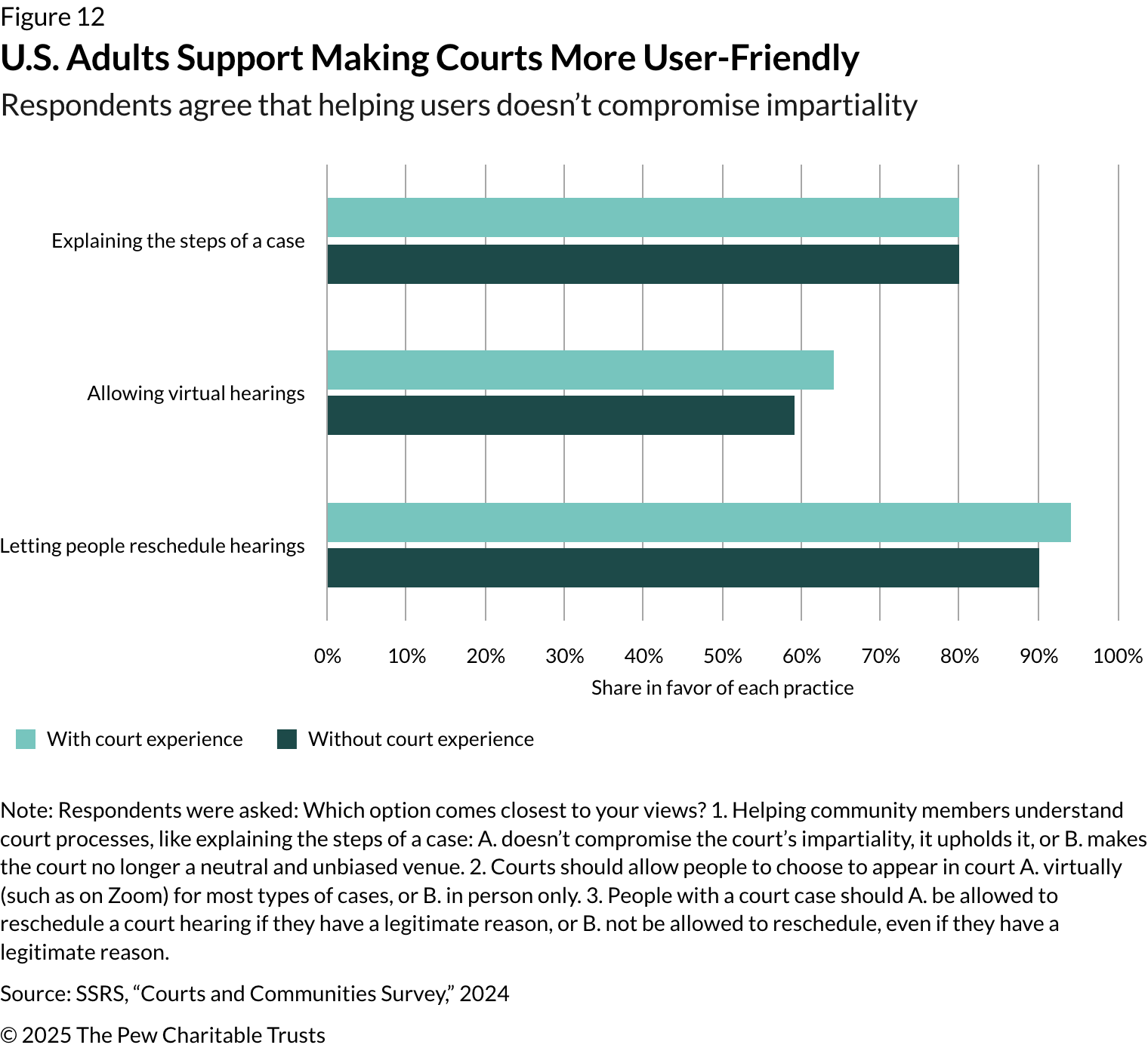Experience With State Courts Highlights Areas for Improvement
National poll shows 1 in 3 adults are in households with court experience, which affects their opinions of the judicial system
Overview
Throughout the country, people rely on state and local courts to resolve a wide variety of issues, from traffic tickets and divorces to debt cases and shoplifting charges.1 These interactions can affect their lives, their communities, and their opinions of the legal system.
To learn more about how people in the U.S. interact with and view courts, The Pew Charitable Trusts conducted a national poll of 2,016 adults in August and September 2024. The poll, administered by public opinion polling firm SSRS, asked individuals about their general perceptions of the state and local courts in their communities, their interactions with these institutions, and their priorities for improving the courts.2 (All data in this chartbook is from the survey unless otherwise noted. See the methodological appendix for more information.)
Across dozens of questions, several key trends emerged. The poll found that 1 in 3 U.S. adults live in households that had been involved in a court case at some point, meaning that either the survey respondent or someone living with them had had a civil or criminal case before a state or local court, by either initiating or defending a case.
Many respondents said that this court experience had taken a toll on their mental and financial well-being. Households with court experience graded courts as "D" or "F" twice as often as those without. Contrary to what people might expect, defendants or those who lose their cases are not the only court users to hold critical views of the courts—the poll found that plaintiffs and winners often do too. For example, almost 1 in 5 people who won their cases nevertheless emerged with less confidence in the courts than when they started, and nearly 3 in 10 said their financial security was harmed. Still, many saw ways that courts could improve: About half of respondents said that state courts should prioritize their resources for the most serious matters before them, such as those that might break up a family or land someone in prison. And people from all walks of life, both with and without court experience, said that state courts should prioritize their resources for the most serious matters before them, including public safety cases.
The poll revealed some of the challenges courts face in effectively interacting with the people they serve and highlighted opportunities for meaningful change. Courts and court stakeholders, including policy experts and community advocates, can use the insights from the poll to guide examinations of state and local courts and identify reforms that can make courts work better for individuals and communities.
Conclusion
Approximately one-third of adults in the U.S. live in households in which someone has defended or initiated a court case, whether it be civil, criminal, family, or traffic-related. Although each person’s court experience is different, common themes emerged across respondent demographics from Pew’s poll: U.S. adults with court experience frequently reported that their court case had a significant negative effect on their emotional and mental health and their financial security, regardless of whether they won or lost. Plaintiffs and defendants alike generally gave courts low marks for usability and ease of navigation.
All respondents, regardless of whether they had experience with the courts, had similar priorities for making courts more effective. Most want courts to be more user-friendly, especially for people without lawyers, and to prioritize their resources for cases with the most serious consequences.
In light of the significant influence that state and local courts hold over people’s lives, court leaders can use these findings about public perception to strengthen public trust.
Data notes
Respondents with “court experience(s)” refers to U.S. adults who said that they or a member of their household have had a court case for a civil, family, traffic, or criminal matter that was not a part of their work or jury duty.
The estimated number of adults with court experience is derived from the total population ages 18 and older, as determined by the American Community Survey in 2022 and used by SSRS in conducting the poll.
Blank, refused, or unknown responses to a given question were excluded from the analysis for that question; these amounted to less than 1% of responses for each question.
Less than 2% of respondents did not select Male or Female, or Republican or Democrat; these responses are not included in analyses related to gender or political party.
About 15% of respondents said that they were not sure if they had won or lost, and 9% said the outcome had not been decided; those responses are not included in the analysis by outcome.
External reviewers
This report benefited from the insights and expertise of Jason Tashea, founding director of Judicial Innovation Fellowship at the Georgetown Law Center, and Colleen Shanahan, practice professor of law at University of Pennsylvania Carey Law School. Although they reviewed various drafts of the brief and findings, neither they nor their organizations necessarily endorse the conclusions.
Acknowledgments
This survey was conducted for The Pew Charitable Trusts by SSRS, an independent research company. More information about SSRS can be found at https://ssrs.com/. The project team also thanks current and former Pew colleagues Demetra Aposporos, Gaby Bonilla, Maria Borden, Maureen Bowers, Erika Compart, Jennifer V. Doctors, Caroline Dufour, Sarah Godfrey, Tricia Olszewski, Chelsie Pennello, Sarah Spell, Chloe Stemler, Drew Swinburne, and Abby Takas for editorial, creative, communications, and research support.
Endnotes
- “State Courts Play a Key Role in American Life,” The Pew Charitable Trusts, 2024, https://www.pew.org/en/research-and-analysis/issue-briefs/2024/10/state-courts-play-a-key-role-in-american-life.
- SSRS, “Courts and Communities Survey” (Survey, commissioned by The Pew Charitable Trusts, 2024).
- The Pew Charitable Trusts, “How Debt Collectors Are Transforming the Business of State Courts,” 2020, https://www.pewtrusts.org/en/research-and-analysis/reports/2020/05/how-debt-collectors-are-transforming-the-business-of-state-courts.
- The Pew Charitable Trusts, “Why America's Civil Courts Need Reform,” 2021, https://www.pew.org/en/trust/archive/summer-2021/why-americas-civil-courts-need-reform.



















